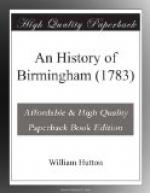The toy trades first made their appearance in Birmingham, in the beginning of Charles the second, in an amazing variety, attended with all their beauties and their graces. The first in pre-eminence is
The BUTTON.
This beautiful ornament appears with infinite variation; and though the original date is rather uncertain, yet we well remember the long coats of our grandfathers covered with half a gross of high-tops, and the cloaks of our grandmothers, ornamented with a horn button nearly the size of a crown piece, a watch, or a John apple, curiously wrought, as having passed through the Birmingham press.
Though the common round button keeps on with the steady pace of the day, yet we sometimes see the oval, the square, the pea, and the pyramid, flash into existence. In some branches of traffic the wearer calls loudly for new fashions; but in this, the fashions tread upon each other, and crowd upon the wearer. The consumption of this article is astonishing. There seem to be hidden treasures couched within this magic circle, known only to a few, who extract prodigious fortunes out of this useful toy, whilst a far greater number, submit to a statute of bankruptcy.
Trade, like a restive horse, can rarely be managed; for, where one is carried to the end of a successful journey, many are thrown off by the way. The next that calls our attention is
The BUCKLE.
Perhaps the shoe, in one form or other, is nearly as ancient as the foot. It originally appeared under the name of, sandal; this was no other than a sole without an upper-leather. That fashion hath since been inverted, and we now, sometimes, see an upper-leather nearly without a sole. But, whatever was the cut of the shoe, it always demanded a fastening. Under the house of Plantagenet, it shot horizontally from the foot, like a Dutch scait, to an enormous length, so that the extremity was fattened to the knee, sometimes, with a silver chain, a silk lace, or even a pack-thread string, rather than avoid genteel taste.
This thriving beak, drew the attention of the legislature, who were determined to prune the exorbitant shoot. For in 1465 we find an order of council, prohibiting the growth of the shoe toe, to more than two inches, under the penalty of a dreadful curse from the priest, and, which was worse, the payment of twenty shillings to the king.
This fashion, like every other, gave way to time, and in its stead, the rose began to bud upon the foot. Which under the house of Tudor, opened in great perfection. No shoe was fashionable, without being fattened with a full-blown rose. Under the house of Stuart, the rose withered, which gave rise to the shoe-string.
The beaus of that age, ornamented their lower tier with double laces of silk, tagged with silver, and the extremities beautified with a small fringe of the same metal. The inferior class, wore laces of plain silk, linen, or even a thong of leather; which last is yet to be met with in the humble plains of rural life. But I am inclined to think, the artists of Birmingham had no great hand in fitting out the beau of the last century.




